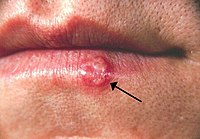
Photo from wikipedia
Viral infection of the central nervous system can result in encephalitis. About 20% of individuals who develop viral encephalitis go on to develop epilepsy. We have established an experimental model… Click to show full abstract
Viral infection of the central nervous system can result in encephalitis. About 20% of individuals who develop viral encephalitis go on to develop epilepsy. We have established an experimental model where virus infection of mice with Theiler’s murine encephalomyelitis virus (TMEV) leads to acute seizures, followed by a latent period (no seizures/epileptogenesis phase) and then spontaneous recurrent seizures—epilepsy. Infiltrating macrophages (CD11b+CD45hi) present in the brain at day 3 post-infection are an important source of interleukin-6, which contributes to the development of acute seizures in the TMEV-induced seizure model. Time course analysis of viral infection and inflammatory [CD11b+CD45hiLy-6Chi] and patrolling [CD11b+CD45hiLy-6Clow] monocyte and T cell infiltration into the brains of TMEV-infected C57BL/6J mice over the entire course of the acute viral infection was performed to elucidate the role of virus and the immune response to virus in seizures and viral clearance. The infiltrating inflammatory macrophages were present early following infection but declined over the course of acute viral infection, supporting a role in seizure development, while the lymphocyte infiltration increased rapidly and plateaued, advocating that they play a role in viral clearance. In addition, we showed for the first time that, while TMEV infection of RAG1−/− mice did not alter the number of mice experiencing acute seizures, TMEV infection of C57BL/6J mice depleted of macrophages resulted in a significant decrease in the number of mice experiencing seizures, again supporting a role for infiltrating macrophages in the development of acute seizures in the TMEV-induced seizure model.
Journal Title: Journal of NeuroVirology
Year Published: 2018
Link to full text (if available)
Share on Social Media: Sign Up to like & get
recommendations!